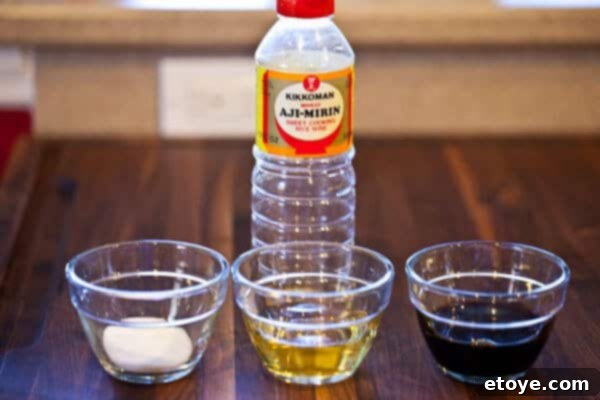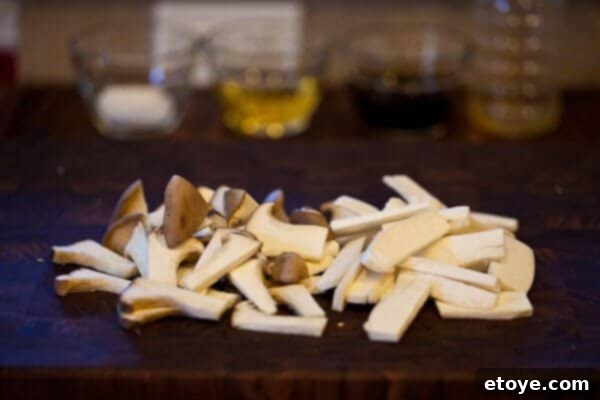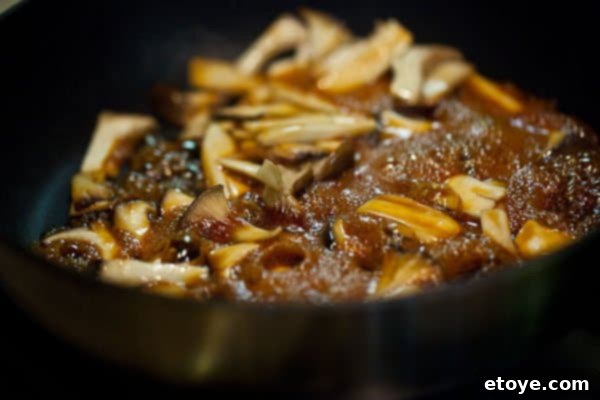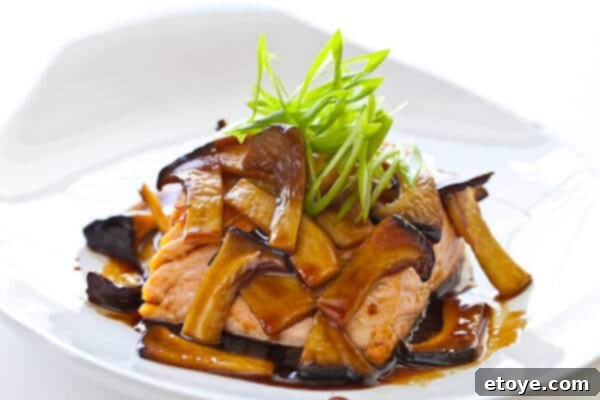Unlock Authentic Flavors: Master the Art of Homemade Teriyaki Sauce with Salmon and Mushrooms

Are you tired of lackluster, overly sweet, and chemically tasting store-bought teriyaki sauces? You’re not alone! Many ready-made sauces available on supermarket shelves are not only expensive but often fall short of delivering that rich, balanced, and authentic umami flavor profile that true teriyaki is known for. It’s time to reclaim your kitchen and discover how incredibly simple, delicious, and cost-effective it is to make your own teriyaki sauce from scratch. Get ready to transform your weeknight dinners into a culinary delight with our incredible Salmon and Mushroom Teriyaki recipe, featuring a homemade sauce that will revolutionize your cooking.
The Secret to Superior Teriyaki: Why Homemade Beats Store-Bought Every Time
Pre-bottled teriyaki sauces are notorious for their high sugar content, artificial additives, and often a flat, one-dimensional taste. They lack the nuanced complexity that comes from fresh, quality ingredients simmered together. By making your own teriyaki sauce, you gain complete control over the flavor, allowing you to adjust sweetness, saltiness, and richness to perfectly suit your palate. This not only results in a far more delicious meal but also avoids unnecessary preservatives and artificial flavors, ensuring a healthier and more natural dining experience. Once you taste the difference, you’ll wonder why you ever settled for anything less. Embrace the joy of crafting your own condiments and experience the profound improvement in your cooking.

Deconstructing Teriyaki: Just Three Core Ingredients for Unforgettable Flavor
At its heart, authentic Japanese teriyaki sauce is surprisingly simple, relying on just three fundamental ingredients: soy sauce, sweet cooking wine (mirin), and sugar. While you can certainly elevate the sauce with aromatics like grated ginger and garlic, or a sprinkle of sesame seeds, the magic truly happens with these core components. The beauty lies in their balance. For those who prefer a less sweet profile, reducing the amount of sugar is an easy adjustment that doesn’t compromise on flavor depth. Understanding these basic building blocks is the first step to mastering perfect homemade teriyaki.
Soy Sauce: The Foundation of Umami and Savory Depth
Soy sauce, or shoyu, is a fermented condiment essential to Japanese cuisine, providing the foundational savory and umami notes of teriyaki. Choose a good quality, naturally brewed soy sauce for the best flavor. Options include light soy sauce (koikuchi shoyu) for general use, or even tamari for a gluten-free alternative, which is traditionally made without wheat. Low-sodium varieties are also available if you’re managing salt intake, allowing you to tailor the sauce to your dietary needs without sacrificing the characteristic depth. The right soy sauce makes all the difference in achieving an authentic taste.
Mirin: The Essential Sweet Rice Wine for Glaze and Flavor
Mirin is a Japanese sweet rice wine, distinct from Chinese rice wine or rice vinegar. It’s a crucial ingredient in everyday Japanese cooking, imparting a mild sweetness, a subtle tang, and a beautiful glaze to dishes. Mirin contains a balance of sugar and rice wine, which contributes to the characteristic sheen (teri) and flavor (yaki) that define teriyaki. You can typically find mirin in the “Asian” or “ethnic” section of most major grocery stores, as well as in dedicated Asian supermarkets. Be sure to select “hon mirin” (true mirin) if possible, as some varieties contain added corn syrup or other artificial sweeteners. Its unique flavor profile is truly irreplaceable for an authentic teriyaki experience, adding a layer of complexity and a beautiful finish that cannot be replicated.
Sugar: Balancing Sweetness to Your Liking and Enhancing Caramelization
While often used in equal parts with soy sauce and mirin in traditional recipes, sugar can be adjusted to personal preference. Some prefer a sweeter teriyaki, ideal for caramelizing and glazing, while others opt for a more savory version. White granulated sugar is commonly used, but you could experiment with brown sugar for a deeper, molasses-like undertone, or even a touch of honey or maple syrup for a different kind of sweetness. Remember, the goal is balance, so taste and adjust as you simmer. The sugar is not just for sweetness; it plays a vital role in creating that signature glossy teriyaki coating.
Optional Enhancements for a Custom Touch: Aromatics and Spices
Once you’ve mastered the basic trio, feel free to experiment with additional flavors. A knob of grated fresh ginger adds a warm, spicy kick, while minced garlic offers aromatic depth. A splash of sake can introduce another layer of umami, and a sprinkle of toasted sesame seeds or a dash of sesame oil can enhance the nutty flavor. These additions are not strictly necessary but can personalize your teriyaki sauce to perfection, allowing you to tailor it to your family’s preferences or specific dietary needs.
Crafting Your Perfect Teriyaki Sauce: A Simple Simmer to Perfection
Making teriyaki sauce is remarkably straightforward. Combine your chosen amounts of soy sauce, mirin, and sugar (along with any optional aromatics like ginger or garlic if you’re using them) in a small saucepan. Bring the mixture to a gentle simmer over low to medium heat, stirring continuously until all the sugar has fully dissolved. This usually takes just about a minute or two. The sauce will thicken slightly as it cools, developing a rich, glossy consistency perfect for glazing. This simple process yields a rich, flavorful sauce that’s miles ahead of any store-bought alternative, ready to elevate a multitude of dishes with its fresh and authentic taste.

Elevating Your Meal with Earthy Mushrooms: A Delicious and Nutritious Addition
While teriyaki sauce is fantastic on its own, adding sautéed mushrooms introduces an incredible depth of flavor and texture, taking your dish from great to extraordinary. Mushrooms, with their natural umami, beautifully complement the savory and sweet notes of the teriyaki, creating a more complex and satisfying meal. They add a wonderful earthy dimension and a delightful chewiness that enhances the overall experience.
The Magnificence of King Trumpet Mushrooms: Texture and Flavor
For this recipe, we highly recommend Hokto’s King Trumpet Mushrooms. These impressive fungi are known for their large, meaty stalks and rich, earthy flavor, offering a substantial bite that holds up wonderfully in cooking. Their robust texture makes them a fantastic substitute for meat in many dishes, and they absorb flavors incredibly well, making them perfect for soaking up that delicious teriyaki sauce. Their unique shape also adds an attractive element to the final presentation.
Versatile Alternatives: Choose Your Favorite Fungi Varieties
If King Trumpet mushrooms aren’t readily available, don’t fret! You can easily substitute them with other fresh mushroom varieties. Shiitake mushrooms offer a distinct earthy and slightly smoky flavor, which pairs beautifully with teriyaki. Crimini mushrooms (baby bellas) are widely available and have a pleasant, mild earthiness, offering a softer texture. Even simple white button mushrooms will work well, providing a great base for the sauce. The key is to use fresh, firm mushrooms that will add both flavor and a delightful textural contrast to your salmon dish, ensuring every bite is interesting and delicious.

Grilled Salmon Perfection: A Healthy, Flavorful, and Quick Protein Option
Salmon is an excellent choice for this teriyaki dish, offering a wealth of health benefits, including omega-3 fatty acids, high-quality protein, and essential vitamins and minerals. Its rich, buttery flavor and flaky texture pair exceptionally well with the sweet and savory teriyaki sauce and earthy mushrooms. Grilling or pan-searing salmon is a quick and effective way to achieve a crispy skin and tender, moist flesh, making it an ideal protein for a weeknight dinner that feels gourmet.
Cooking Your Salmon: Expert Tips for Success
Whether you choose to grill or pan-sear your salmon fillets, proper seasoning and cooking technique are key. A simple brush of cooking oil, followed by a generous sprinkle of salt and freshly ground black pepper, enhances the salmon’s natural flavor. For pan-searing, heat your pan over high heat until it’s very hot, then cook the salmon skin-side down first to crisp it up, about 3-4 minutes per side, depending on thickness. You’re looking for an internal temperature of 145°F (63°C) for medium-cooked salmon, or until it flakes easily with a fork. Don’t overcook it, as salmon can dry out quickly. Resting the salmon for a few minutes after cooking also helps keep it moist and juicy.
Bringing It All Together: Your Delectable Salmon & Mushroom Teriyaki Masterpiece
The final assembly is where the magic happens. After sautéing your mushrooms until they’re softened and fragrant, pour in your freshly made teriyaki sauce. Let it simmer with the mushrooms for just another minute, allowing the flavors to meld beautifully and the sauce to lightly coat the fungi. This mushroom teriyaki mixture is then ready to be generously spooned over your perfectly grilled or pan-seared salmon fillets. The combination of succulent salmon, savory mushrooms, and vibrant homemade teriyaki sauce creates a dish that is both elegant and incredibly comforting. The contrasting textures and balanced flavors make every bite a delight. Serve immediately over fluffy steamed rice or a bed of stir-fried noodles for a complete and satisfying meal that will impress.

Recipe: Teriyaki Mushroom Salmon
Prepare this delicious and healthy meal in minutes, featuring perfectly cooked salmon, savory mushrooms, and an irresistible homemade teriyaki sauce that’s far superior to store-bought options.
Prep Time: 5 mins
Cook Time: 10 mins
Servings: 4
Ingredients
- 4 (6 oz) salmon fillets
- Salt and freshly ground black pepper, to taste
- 12 ounces fresh king oyster mushrooms or fresh shiitake mushrooms, sliced
- 1 1/2 tablespoons cooking oil, separated
- 1 stalk green onion, thinly sliced (optional, for garnish)
For the Easy Teriyaki Sauce:
- 1/4 cup soy sauce
- 1/4 cup mirin (Japanese sweet rice wine)
- 2 tablespoons sugar (adjust to preferred sweetness, or use less for a savory profile)
- (Optional: 1/2 teaspoon grated fresh ginger, 1 clove minced garlic for added aromatics)
Instructions
- Prepare the Teriyaki Sauce: In a small saucepan, whisk together soy sauce, mirin, and sugar (and optional ginger/garlic, if using). Bring the mixture to a gentle simmer over low heat, stirring continuously until the sugar dissolves completely and the sauce thickens slightly (about 3 minutes). Remove from heat and set aside to cool slightly.
- Cook the Salmon: Lightly brush salmon fillets with 1 tablespoon of the cooking oil and season generously with salt and black pepper on all sides. Heat a large frying pan (or preheat your grill) over high heat until very hot. Place the salmon fillets skin-side down (if pan-searing) and cook for 3-4 minutes on each side, or until the salmon is just cooked through and flakes easily with a fork. Remove the salmon from the pan and set aside on a plate to rest.
- Sauté the Mushrooms: Return the same frying pan to the stove over medium-high heat. Add the remaining 1/2 tablespoon of cooking oil. Add the sliced mushrooms to the hot pan and sauté for about 2 minutes, stirring occasionally, until they begin to soften and release their moisture.
- Combine and Serve: Reduce the heat to low, then pour the prepared teriyaki sauce over the sautéed mushrooms. Let it simmer gently for 1 minute, allowing the mushrooms to fully absorb the rich flavors of the sauce. Spoon the glistening teriyaki mushrooms generously on top of the cooked salmon fillets. Garnish with thinly sliced green onion, if desired, for a touch of freshness and color. Serve hot.
Notes
- This basic teriyaki sauce recipe is incredibly versatile; feel free to use it as a marinade or glaze for other proteins like chicken thighs, thinly sliced beef, pork, or even firm tofu for a delicious vegetarian option.
- For a gluten-free option, always ensure you use a certified gluten-free soy sauce (such as tamari). Mirin is naturally gluten-free.
- The King Trumpet Mushrooms mentioned are often sourced from Hokto Kinoko, a producer known for their premium quality Japanese mushrooms.
Variations and Serving Suggestions for Your Teriyaki Feast
The beauty of this homemade teriyaki sauce and its combination with mushrooms and salmon lies in its adaptability. Don’t hesitate to experiment with different proteins and vegetables! You can easily swap salmon for other delicious options like chicken thighs, thinly sliced beef, or even firm tofu for a robust vegetarian option. For a richer flavor profile with chicken or beef, consider marinating the protein in a portion of the teriyaki sauce for at least 30 minutes before cooking. Add steamed or stir-fried vegetables like crisp broccoli florets, vibrant snap peas, colorful bell peppers, or tender asparagus to your dish for extra nutrients, texture, and a beautiful presentation, making it a truly complete meal.
This dish is fantastic served alongside a bowl of hot, fluffy white rice, which perfectly soaks up the extra teriyaki sauce, ensuring no drop of flavor goes to waste. For a healthier or heartier alternative, consider brown rice, quinoa, or cauliflower rice. A simple side salad with a light vinaigrette would also complement the richness of the teriyaki beautifully, adding a refreshing contrast. Remember, presentation matters! A final sprinkle of toasted sesame seeds or a few chili flakes can add both visual appeal and an extra layer of nutty or spicy flavor, elevating your dish to restaurant quality.
Conclusion: Embrace the Simplicity and Superiority of Homemade Teriyaki
Ditching the bottled stuff for homemade teriyaki sauce is more than just a recipe; it’s a culinary revelation. It’s a testament to how a few simple, high-quality ingredients, when combined with care, can create a world of difference in flavor and dining experience. This Salmon and Mushroom Teriyaki recipe is not just a meal; it’s an invitation to explore the authentic, rich tastes of Japanese cuisine right in your own kitchen. With minimal effort and maximum reward, you’ll be whipping up gourmet-quality dinners that are healthier, more delicious, and incredibly satisfying. So, gather your ingredients, follow these simple steps, and prepare to impress yourself and your loved ones with the undeniable magic and freshness of homemade teriyaki.
